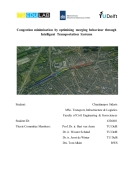The main cause of congestion is the highway demand exceeding the capacity. Especially in bottleneck locations, congestion is more easily formed. On-ramps are among these locations, where vehicles from the on-ramp and vehicles on the highway want to use the same infrastructure. Merging is a sub-component of lane changing; it refers to lane changes but only regarding vehicles entering a new traffic stream. The interference between merging and highway vehicles results in disturbances at the merging location leading to congestions upstream. The objective of the research described in the report is to define which Intelligent Transportation Systems (ITS) are the most suitable for this problem and what their performance will be.
The method with which the ITS performance will be examined is simulation and the programme that will be used is MOTUS. The main advantage of MOTUS is that it offers the capability of expanding the already existing classes and incorporating new features. The first step is the design of the examination site. The site is divided in smaller segments. Each segment is divided from its previous and next ones when their characteristics differ, e.g. number of lanes. MOTUS consists of two models: the longitudinal (car-following) and the lateral (lane changing). The parameters used in the simulation are divided according to these two models and based on the Lane Change Model with Relaxation and Synchronisation (LMRS). The basic component of LMRS is lane change desire. However, at a smaller extent it incorporates car following, which is described by the adapted version of the Intelligent Driver Model (IDM+). In the second step the parameters are calibrated in order for the simulated data to have a good fit with the real data. The calibration did not give a perfect fit. For example, congestion in reality begins at the end of the acceleration lane, while in simulation it begins at the merging point. On the other hand, the right lane is both in simulation and in reality more congested than the other two lanes and at the merging point the speeds and flows in simulation have a very good fit with reality. The next step is the definition of the applied manoeuvres by the drivers. These are the following two: courtesy yielding by reducing speed and lane changing towards the left.
The aforementioned measures will be applied with the contribution of the merging assistant. This assistant consists of two component: a roadside unit (RSU) located at the merging point and Adaptive Cruise Control (ACC) equipped vehicles. A defined percentage of vehicles is ACC-equipped. In those vehicles, drivers can apply the desired (or advised) headway and the ACC will maintain it until the order changes. The instructions transmitted to ACC-equipped vehicles will differ from the ones transmitted to manual vehicles. The simulated scenarios are the following: only-controller scenario: during this scenario all vehicles are manual, thus the ACC penetration rate (pACC) is set to 0%; only-ACC scenario and during this scenario the RSU is never active and finally a combination of the above scenarios. The simulation results show that only ACC or a combination gives the best results.
Despite the positive outcomes of the proposed system, there are still certain aspects that could be improved. For example, it would be better if more days were tested so that the sample would be more robust give more certain results. Furthermore, certain assumptions (e.g. trucks remaining on the right lane) were initially made. These assumptions could be excluded in future research. The last recommendation refers to human behaviour. This is a factor that can never be defined with 100% precision. Even the compliance rate is a very general variable, since a driver may comply with certain instructions, but not all of them. The way to tackle this problem is the maximisation of tests with different input every time in order to obtain results as robust as possible.
